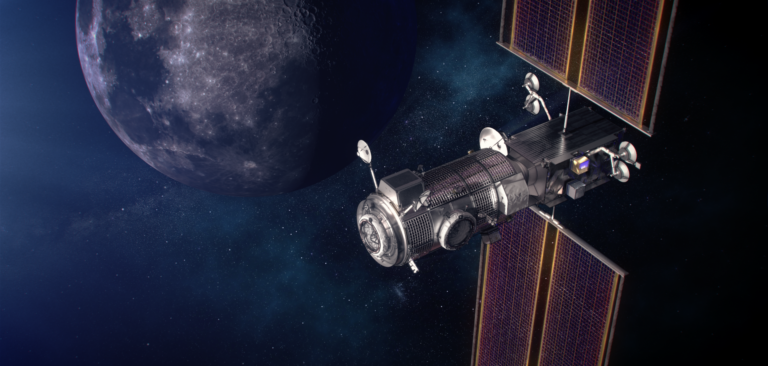The planned Artemis missions to the moon will, according to NASA, benefit from two weather instrument suites, NASA’s HERMES and ESA’s ERSA.
The instrument suites, named after two of Artemis’s half-siblings in Greek Mythology – Ersa, the goddess of dew, and Hermes, the messenger of the Olympian gods – will be pre-loaded on the Gateway (above), the planned moon orbiting outpost, before the first two components are launched: the Power and Propulsion Element and the Habitation and Logistics Outpost. The two instrument suites will begin monitoring the lunar radiation environment and return data before crews begin to arrive.
NASA and the European Space Agency (ESA) are each building one of the instrument suites, both capitalizing on technologies that were mature enough to be delivered by mid-2022. The two complementary mini weather stations will split up the work, with ERSA monitoring space radiation at higher energies with a focus on astronaut protection, while HERMES will monitor lower energies critical to scientific investigations.
Earth’s magnetic field, which extends approximately 60,000 miles into space, protects Earth and most space operations in near-Earth orbit from solar winds. However, as the moon orbits, it passes in and out of Earth’s long magnetotail, the part of Earth’s magnetic field blown back by the solar wind like a windsock. Gateway, however, will spend only a quarter of its time within this magnetic field, providing a research opportunity to directly measure the solar wind and radiation from the sun.
HERMES, short for Heliophysics Environmental and Radiation Measurement Experiment Suite, will study what’s happening deep in the magnetotail, allowing NASA to compare its observations to two of the five THEMIS spacecraft, a pair of moon-orbiters that carry some similar instruments as HERMES.
It consists of four instruments mounted together on a platform: a magnetometer, which measures the magnetic fields around Gateway; the Miniaturized Electron Proton Telescope (MERiT), which measures ions and electrons; the Electron Electrostatic Analyzer (EEA), which measures the lower energy electrons that make up most of the solar wind; and the Solar Probe Analyzer for Ions, or SPAN-I, which measures protons and ions including oxygen. The magnetometer, MERiT and EEA are provided by Goddard; SPAN-I is built at the University of California, Berkeley.
NASA notes that the ability to collect data simultaneously from the three instrument suites in different locations will provide an opportunity to reconstruct solar wind behavior as it changes over time. HERMES will also measure lower energy radiation that will be considered for astronaut safety where applicable, but its primary goal is scientific.
Meanwhile, ERSA (European Radiation Sensors Array) will study the solar wind’s effects on astronauts and their equipment. Equipped with five instruments, ERSA measures energetic particles from the sun, galactic cosmic rays, neutrons, ions and magnetic fields around the Gateway. Measuring these particles can tell us about the physics of radiation in the solar system, and understand the risks posed by radiation to human spacefarers and their hardware.
Also included in the suite is the Influence sur les Composants Avancés des Radiations de l’Espace, or ICARE-NG instrument, which measures ionizing radiation that can create brief spikes in voltage that can make electronics short-circuit. Another instrument, the European Active Dosimeter, which measures the energy that would be deposited by radiation in living tissue to understand human radiation exposure, will also be included in the system.



